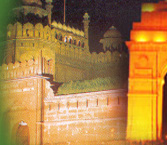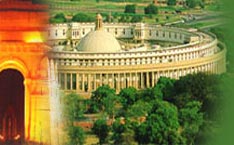Jama Masjid is located in Old Delhi, the city that was built by Mughul Emperor Shahjahan and known as Shahjahanabad. The immense mosque was built in the 17th century along with the new city, and was meant to serve as the principal mosque of the empire. The magnificent structure is still the largest mosque in India, and the most important one as well. It is also one of the major tourist spots in Delhi. The formal name given to the mosque was Masjid-i-Jahan Numa meaning "mosque commanding a view of the world".
Jama Masjid in Delhi is one of the most prominent structures in the city. The immense mosque is made up of red stone and marble. No expenses were spared by Shahjahan, an avid builder among the Mughuls, for the construction of the mosque which was completed in 1656. A total of 5000 workers are said to have worked on the mosque, and the cost estimated was Rupees ten lakhs (one million), an astronomical sum in those days. The splendid religious building is yet another example of the high levels attained by the architects under Mughul patronage in India. Like most areas of old Delhi, this revered mosque also saw a great deal of bloodshed and plunder during the repeated attacks by invaders and during the siege of Delhi by the British in 1857. The north east corner of the mosque contains precious relics from Prophet Muhammad, like a hair from his beard, used footwear and pages from the holy Quran written on deer skin.
The mosque has a vast courtyard that can accommodate up to 25 000 people. Massive religious gatherings are seen here on the major occasions of the Muslims. The architecture of the mosque, like so many of the Mughul buildings, reflects the indo-Islamic style. The minarets, domes, arched gateways and pavilions are the main features of the mosque. The landscape of Delhi has been dominated by the minarets of the Jama Masjid ever since it was built, and it is impossible to visualize Delhi without this mosque. Even today, after three and a half centuries, the Jama Masjid continues to be the center of attraction of Delhi along with the Red Fort, the two surviving mega structures of Shahjahan�s city.
The bustling Chandni Chowk runs from the Jama Masjid to the Red Fort, one of the most famous tourist attractions of Delhi. Tourists visiting the city should definitely visit this mosque along with the Red Fort and the other historical monuments of the city.
Touristplacesinindia.com offers online information about Jama Masjid in New Delhi, and other tourist places in India.
 |
| 


